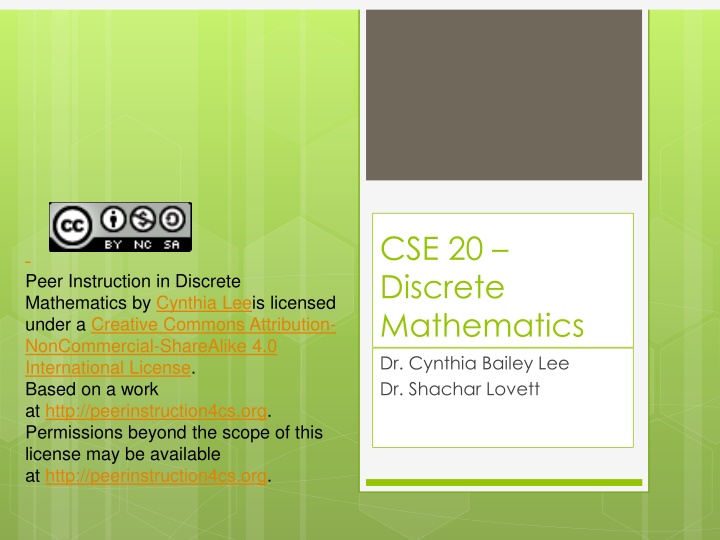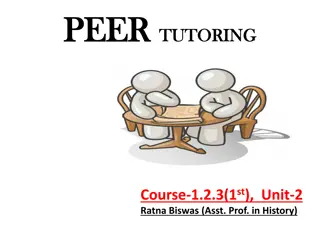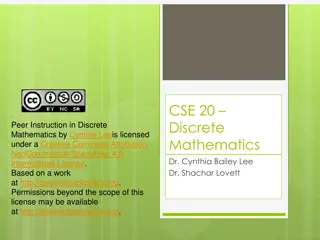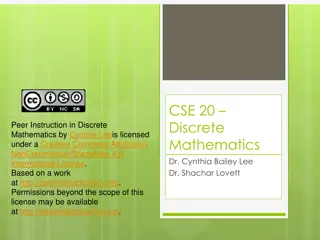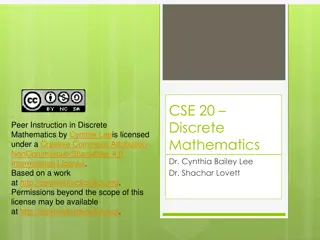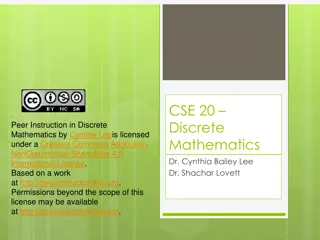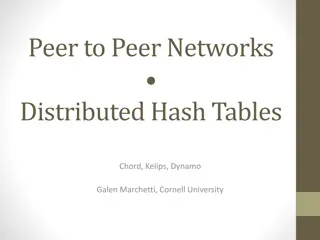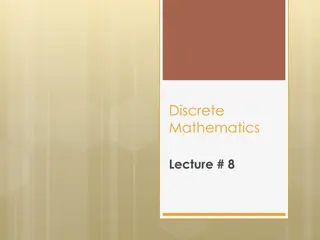Peer Instruction in Discrete Mathematics Overview
Explore the fundamentals of discrete mathematics through Predicate Quantifiers, Paradoxes, and Proof Strategies in Peer Instruction. Gain insights on Predicate Love examples and strategies for proving or disproving quantified statements. Enhance your understanding of nested quantifiers and predicate visualization. Learn how to disprove predicates through counterexamples and correct version statements.
Download Presentation

Please find below an Image/Link to download the presentation.
The content on the website is provided AS IS for your information and personal use only. It may not be sold, licensed, or shared on other websites without obtaining consent from the author.If you encounter any issues during the download, it is possible that the publisher has removed the file from their server.
You are allowed to download the files provided on this website for personal or commercial use, subject to the condition that they are used lawfully. All files are the property of their respective owners.
The content on the website is provided AS IS for your information and personal use only. It may not be sold, licensed, or shared on other websites without obtaining consent from the author.
E N D
Presentation Transcript
Creative Commons License CSE 20 Discrete Mathematics Dr. Cynthia Bailey Lee Dr. Shachar Lovett Peer Instruction in Discrete Mathematics by Cynthia Leeis licensed under a Creative Commons Attribution- NonCommercial-ShareAlike 4.0 International License. Based on a work at http://peerinstruction4cs.org. Permissions beyond the scope of this license may be available at http://peerinstruction4cs.org.
2 Today s Topics: 1. Predicate Quantifiers 2. Paradoxes
3 1. Predicate Quantification Sometimes and all the time.
4 I m going to assume you know this from the reading: For all even numbers x and y, the sum of x and y is also even. ?,? ?, ? + ? ? There exists an integer g such that g is greater than 5. ? ? ?.?. ? > 5
5 We re going to focus on: Nested quantifiers/more than one quantifier General strategy for proving (or disproving) quantified statements
6 Which picture represents the predicate? (Predicate Love(x,y) means x loves y , denoted by arrow from x to y) A. B. C. D. None/more/other
7 Which picture represents the predicate? (Predicate Love(x,y) means x loves y , denoted by arrow from x to y) A. B. C. D. None/more/other
8 Proof strategies overview (more coming later in the quarter) For a universally quantified ( for all ) statement: To prove it: Mathematical induction, direct proof, generalization from the generic particular (construction) To disprove it: Provide a single counterexample For an existentially quantified ( there exists ) statement: To prove it: Provide a single example To disprove it: State the correct version as a universally quantified statement ( For all x, not P(x) ) then prove it using above methods
9 How could we disprove the predicate? (Predicate Love(x,y) means x loves y ) ? ?.????(?,?) A. By counterexample: show there is a person who loves everyone B. By counterexample: Show there is a person who loves no one C. By counterexample: Show there is a person who nobody loves D. By counterexample: Show there is a person who everyone loves E. Other/more/none
10 What is the correct negation of the predicate? (Predicate Love(x,y) means x loves y ) ? ?.????(?,?) A. ? ?.~???? ?,? B. ? ?.~????(?,?) ? ?.~???? ?,? C. D. ? ?.~????(?,?) E. Other/more/none
